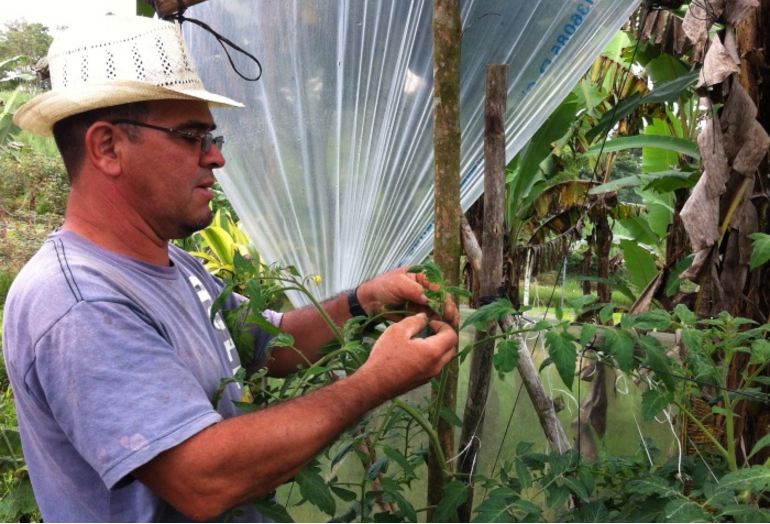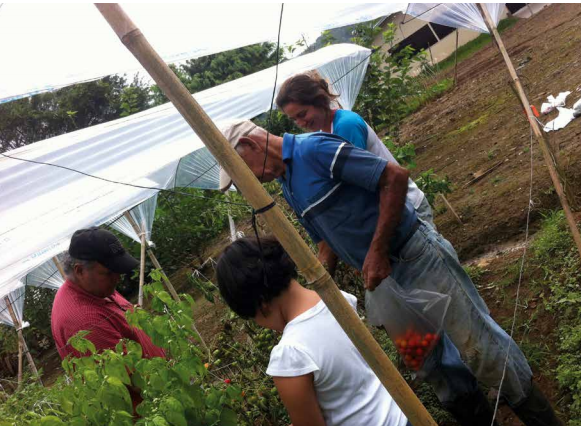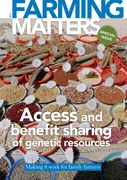A group of coffee farmers in Turrialba, Costa Rica, is successfully exploring diversification options with horticultural food crops. This is being done in collaboration with two vegetable seed banks that allow farmers to use varieties freely under the multilateral system of FAO´s International Treaty on Plant Genetic Resources for Food and Agriculture.

Experiments with tomato and sweet pepper varieties were successful and the results show promise for continuing to encourage farmers in gaining access to horticultural crop genetic resources. The resulting diversity could be the basis for diversified farming systems that are more resilient under progressive climate change and in the context of price volatility, while providing nutritious food crops as well. This case study therefore calls for the inclusion of more horticultural crops in the annex 1 list of species covered by the multilateral system (see this article on theory and practice of ABS), such as tomato and sweet pepper.
Why mix coffee production with tomato and sweet pepper?
In Turrialba, Costa Rica, climate change and low coffee prices motivated small scale coffee farmers to spread risk and diversify their farms by integrating new crops. Eight small scale coffee farmers in Turrialba chose to participate in an experiment with tomato and sweet pepper led by the Tropical Agricultural Research and Higher Education Centre (CATIE). These crops were chosen for the experiment for the following reasons:
1) Farmers in this region have expressed strong interest in horticulture crops as alternative cash crops complementary to coffee, as well as for domestic consumption;
2) CATIE’s gene bank maintains highly diverse collections of these two crops, which provides the necessary variety for selection of interesting materials, and are openly accessible under the multilateral system (MLS) established by FAO´s International Treaty on Plant Genetic Resources for Food and Agriculture (ITPGRA).
The experiment’s premise is that diversified farming systems are often ecologically and economically more resilient than those with less components. Diversified systems provide farmers a range of benefits, including stable income and production, as well as diverse food for consumption. This diversity has led to systems becoming more resilient to climate change and price volatility.
However, farmers often do not have access to appropriate seed material to diversify their systems with food and/or cash crops of their interest. In this project we explore how access to diverse genetic material can improve a farmer’s ability to effectively diversify their farm in a way that makes it resilient and sustainable.
How did farmers conduct the experiment?
Eight farmers, four organic and four conventional, were invited to participate in the study based on their interest in diversification and willingness to participate. The farmers evaluated three types of tomato and sweet pepper varieties. These included (a) popular commercial varieties, (b) traditional varieties from CATIE’s seed bank that were selected according to farmer preferences indicated in initial interviews, and (c) new varieties that were developed by breeders from the World Vegetable Centre (AVRDC) in Taiwan to respond to specific biotic and abiotic conditions in Central America. Seeds from CATIE’s seedbank were ordered using the Standard Material Transfer Agreement (SMTA, see this article) developed by the International Treaty on Plant Genetic Resources for Food and Agriculture.
Seeds of the AVRDC varieties were obtained by CATIE after signing a SMTA to test them in Central America. In addition, the commercially most common tomato and sweet pepper varieties were ordered from a local greenhouse.After the seedlings were transplanted to each farm, plastic bands were installed as protective roofs above each variety. Conventional and organic seedlings were given to each producer, along with a management guide that was used to ensure that the same management approaches were used at all farms.
Each farm was visited once a week from the time the transplant began in April 2015 until the end of the field experiments in November 2015. During the visits, the following data was recorded: (a) morphological and evaluation data of each variety, (b) site characterisation of each farm, (c) management evaluation of each producer, (d) climate data, (e) yield data, (f) participatory evaluations with the producers, and (g) individual interviews with the producers about their preferences.
Farmers’ preferences

Many factors affected the variety preferences of each farmer, including the type of management used on the farm and local market factors as well as local biotic factors. Although many farmers appreciated the commercial varieties because of their pest and disease resistance and their high yields, several CATIE accessions as well as a few AVRDC varieties were ranked either equally or more preferred than the commercial varieties.
Most of the producers involved in this project expressed satisfaction with the unfamiliar varieties that were brought to their farms. Rosa Hernández Céspedes, a coffee farmer who has been trying to diversify her 7 hectare farm for the last eight years, is very excited: “These new varieties also give us something new to sell. The local people want new kinds of vegetables, new options, but I never knew where to find the seeds. So I have started saving the seeds from the new varieties and I can now sow my own seedlings and produce these great vegetables again.”
What started out as purely a coffee plantation had already been converted by Rosa into a diverse organic farm that now includes a vegetable greenhouse, a restaurant and tree nursery. Yet, before her involvement in this project Rosa had limited success in diversifying with vegetables: “I always planted the same commercial varieties of vegetables, including commercial varieties of tomato and sweet pepper. But with this project, I have discovered many traditional varieties of great quality, some of which are more resistant to the increase in rain we have had this year. It’s great to have all of these new options on the farm.”
For farmers like Rosa who are searching for diverse products with unique characteristics, the traditional CATIE varieties were of most interest. Many of the traditional varieties tested in the study showed characteristics that were appealing to these farmers, such as high resistance to pests and diseases as well as fruit forms that were uncommon, but often preferred. The commercial varieties were often most preferred by producers selling strictly to the conventional market.
What lessons can be drawn from this study? This study shows the importance of facilitating farmers’ and breeders´ access to the genetic resources of horticultural crops and the key role that could be played by accessible collections, such as those of CATIE and AVRDC. Tomato and sweet peppers, as well as other important vegetable crops like cucurbits, are not yet part of the list of crops that are covered directly by the multilateral system. This means that access to a wide range of varieties for these crops is difficult to obtain for small scale family farmers due to the bureaucracy, cost and intellectual property rights involved.
Access to a range of varieties of horticultural crops is difficult to obtain for family farmers due to the bureaucracy, cost and intellectual property rights
Although the resources contained within gene bank collections are important, without proper access to particular information for farmers, breeders and agronomists, the material cannot be used efficiently. In this study for example, morphological data of gene bank accessions were used to select the varieties according to farmer preferences and in the evaluation their on-farm potential under different conditions. It´s important that such morphological characterisation and evaluation data is made accessible by seed banks to enhance its use by different actors. On the basis of this study, we propose six measures to improve access to plant genetic resources for growers and breeders once the crops are included in the MLS:
1) A clear documentation system with relevant information on agronomic and other commercial properties of the crops covered by the MLS collection is made available in accessible language and media;
2) An online system to directly request seeds and also includes contact data for farmers to call in case of questions;
3) Active assistance to farmers for negotiating a Standard Material Transfer Agreement ;
4) Establishment of straightforward paymentsystems that cover the costs for regeneration of the material by the gene bank, which should remain economically accessible to farmers and breeders;
5) Distribution of hardcopy catalogues that include the most promising materials and contact data to farmers and relevant organisations;
6) Increasing the number of on-farm participatory varietal validation research projects with farmers.
When farmers have better access to the information and seed material that is currently available in seed banks, they can broaden the genetic base of their crops. Our research shows that this is of interest to individual farmers and organisations who seek to diversify their farms to respond to climatic and/or economic shocks, and to strengthen their management of crop varieties by developing participatory evaluation and breeding programmes.
Farmer based experimentation and peer learning
Farmers like Rosa are motivated to seek out new varieties and new markets to enhance their adaptive capacity. However, many producers have lost essential knowledge about ecosystem resilience and the way that diverse, traditional seed systems contribute to this resilience. Therefore, knowledge sharing must also be enhanced in addition to improved access to gene bank material under multilateral seed systems if the material is going to be used effectively.
However, this genetic material cannot simply be brought back to farms by outside intermediaries. Rather, we have seen that knowledge sharing works best when innovative smallholder farmers like Rosa encourage other producers to seek out new material, multiply and breed diverse varieties. Such horizontal learning and farmer based experimentation should be at the centre of knowledge sharing processes, in which other parties (scientists, NGOs) can play a supportive role. This will contribute to the effective use of genetic resources for more resilient and sustainable farming communities.
Lindsey Hethcote (lhethcote@gmail.com) is a student at CATIE, Escuela de Posgrado, Turrialba, Costa Rica
Maarten van Zonneveld (m.vanzonneveld@cgiar.org) is Associate Scientist with Bioversity International, Costa Rica Office, Turrialba, Costa Rica
William Solano (wsolano@catie.ac.cr) is a researcher at CATIE, Turrialba, Costa Rica
V. Ernesto Méndez (ernesto.mendez@uvm.edu) is a researcher at the Agroecology and Rural Livelihoods Group, University of Vermont, Burlington, United States
Nelly Vasquez (nvasquez@catie.ac.cr) is academic coordinator of the agroforestry and sustainable agriculture masters program at CATIE, Turrialba, Costa Rica
This project was developed by CATIE, Bioversity International and the University of Vermont. It was financially supported by CATIE, Bioversity International, Hivos, CCAFS and the World Vegetable Center (AVRDC). We thank Rosa Hernández Céspedes and all other seven farmers who participated in this project.

